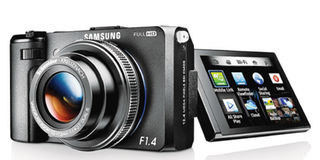Android-powered camera with Internet connectivity

PHOTO | FILE With Wi-Fi and Internet access, Samsung has improved on content sharing.
What you need to know:
- Gadget from tech firm Samsung expected to redefine the aspect of digital point-and-shoot camera world
Samsung Electronics is tinkering with smart technology in a bid to break new ground in the camera line of products.
The latest product from the Korean tech giant is a ‘smart’ camera that runs on Android software and connects directly to the Internet for easy sharing of photos. The gadget is expected to re-define the aspect of digital point-and-shoot-camera technology.
The Galaxy camera is an innovative integration of Android software and camera technology. Unlike others available it is connected to the virtual world for easy sharing of content. Technically, the gadget has smart-phone capabilities blended with powerful camera and photography features. It is half point-and-shoot, half phone.
On the front is a 4.8 inch touch screen. At the rear is the camera’s hood which features a 16.3 megapixel lens with a 21x zoom. Pictures taken have a pixel density of 4,608 by 3,456 pixels. The 21x zoom is easy to control from the touch screen and by use of physical controls as well.
Samsung has equipped the gadget with Google’s latest version of Android operating system, a quad-core processor and extra storage for photos. The gadget runs any Android app available from Google’s store.
In a bid to enhance its photography features, Samsung has a dedicated camera app for the Galaxy Camera. The ease of connectivity to networks allows a user to share photos instantly.
Users can share photos using 3G Internet, built-in Wi-Fi access, Instagram as well as third party tools. For storing photos and data, the Galaxy Camera comes with 8GB of space and expandable microSD of up to 64GB.
To give the gadget extra storage facility, there is availability of cloud computing storage space provided by Google and Dropbox.
Clearly, the Galaxy Camera borrows heavily from Samsung’s Galaxy SIII phone. To some users the gadget is a camera with phone features.
With the gadget, you can check your mail, browse the web and connect to any cell network since it has provision for a SIM card.
However, Samsung seems to have been very careful to avoid making the gadget look like a blown-out smartphone. The company avoided installing a calling feature on the Galaxy Camera.
On top of the gadget is a shutter release button surrounded by a zoom switch for physical control. The dedicated camera app is another clear feature.
With the help of the app and the powerful software of the camera, one is able to edit and achieve the most admirable photos or videos.
The camera comes with a number of photo shooting options, namely, Auto, Casual, Smart Pro and Expert. For the experienced photographers, the menu includes Shutter Priority, Aperture Priority and Manual exposure.
Looking at the way the gadget functions, it seems Samsung’s idea was to make photography both easy and fun in terms of management and sharing.
This is a trendy approach to an old line of products that are facing stiff competition from the advent of smartphones.
Digital cameras are among the gadgets which are threatened by adoption of phone photography. Most of the cameras are designed with pure photography in mind thus rendering them less effective in instant dispatching of the images to third parties.
By incorporating Wi-Fi and Internet access on the gadget, Samsung has improved on the aspect of sharing content thus breathing a lease of life in a digital camera.
Bottom-line
The Wi-Fi technology on cameras has been around for sometime but it’s yet to capture the creative imaginations of a number of photographers. Sony and Nikon have tinkered with the technology with less appeal to consumers.
Instead, users are lured by the ease of capturing photos with the aid of smartphones. The controls, power of the Samsung camera and data connection to cell networks or Wi-Fi are a trendy boost to the gadget.
The innovative apps designed for streamlining the process of editing, uploading and sharing of content from the camera are quite outstanding.
However, the camera faces a wave of phone-photography and competition from other Wi-Fi enabled cameras.
The author is an ICT analyst and a telecommunication engineer.




